I have spent the better part of my comics-reading life trying to connect with the X-Men.
It’s not for a lack of trying really, I promise. I can concede to a certain beauty in the franchise’s gift for connecting with those of us who feel “other.” I can always admit that the books — at least in many previous eras — have featured some of the most unique, playful, and sometimes downright stunning art to grace a comics page. For that matter, I can easily say “well, that was good fun” after plowing through a run of X-Men single issues. All of these things are possible and I freely admit to experiencing them. What gets me though is… well… the X-Men have spent the last six decades being angry. So why haven’t they really done anything about it?
The answer to that, as anyone who has any insight into how comics work already knows all too well, and to largely no fault of the creators, is, of course, “Because Marvel” – or, perhaps, “Because American comics.” Even still: fuck that. After over half a century, why can’t we see something really happen? Something with consequences and the flipped tables and spiked bats? Well, the good news is, you can. That’s where Strontium Dog — the British comic strip celebrating its 45th anniversary this very weekend — comes in, with steel-toed boots, a mean stare, and a lumpy head.
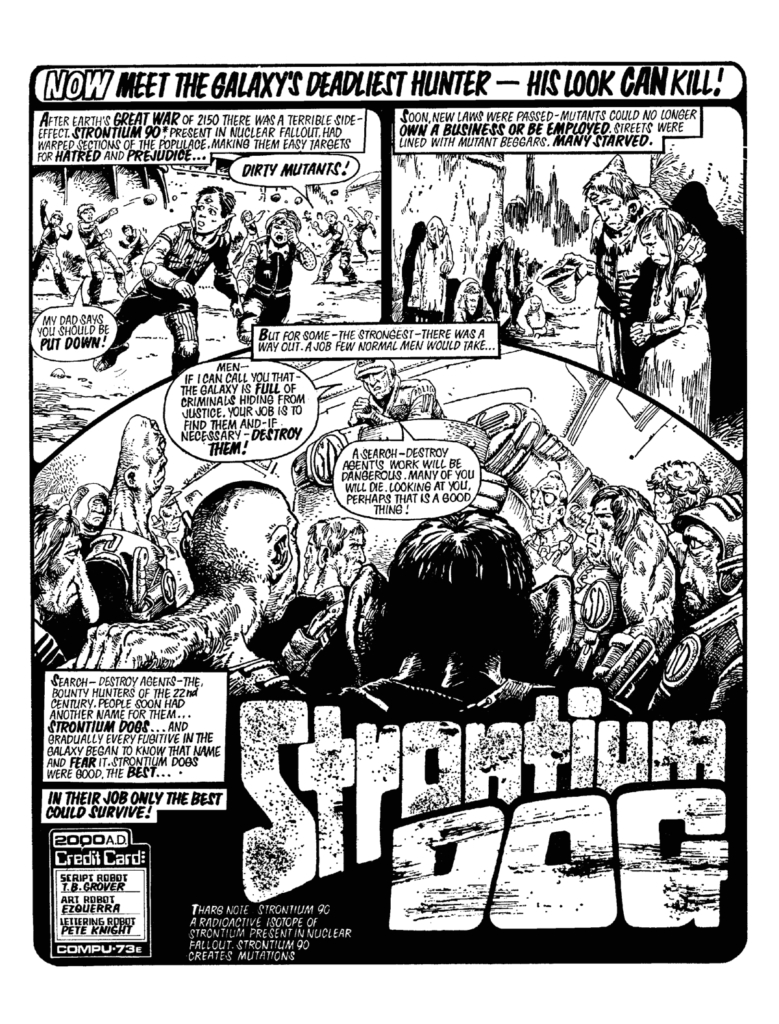
Similar to the shared-universe lawman Judge Dredd – the two have crossed over on a handful of occasions, of course – Strontium Dog arrived initially as a product of the sci-fi and punk rock anarchy period of the late 1970s. Initially part of the anthology comic Starlord, the first run of Strontium Dog ended abruptly, as Starlord failed to win over the UK kids of the era and was dropped like a hot potato after a brief 22-issue run. Thankfully, you just can’t can’t keep good dogs down, and co-creators John Wagner and Carlos Ezquerra (as well as later co-writer Alan Grant) continued the story in the pages of none other than Britain’s nerdiest pride and joy: 2000 AD.
The eponymous band of bounty hunters — Strontium Dogs or “Stronts”, a title derived from their badges reading “SD,” which marked them as official “Search and Destroy agents” — is comprised of mutants affected by the Great Nuclear War of 2150. Their exposure to the radioactive isotope Strontium-90, has left them — and a large swathe of the population of Britain — with a second-class-citizen treatment, oppression, and some seriously bizarre mutations ranging from a lumpy head (or a “lumpy heid,” if you’re in the know) to their face growing out of their kneecaps. In the case of the strip’s main character, the marvelously named Johnny Alpha — son of the strip’s first antagonist and bigoted politician Nelson Kreelman — the mutation doesn’t ruin his rugged good looks, but gives him a set of glowing eyes able to emit alpha-radiation in order to see through objects and read peoples’ minds.
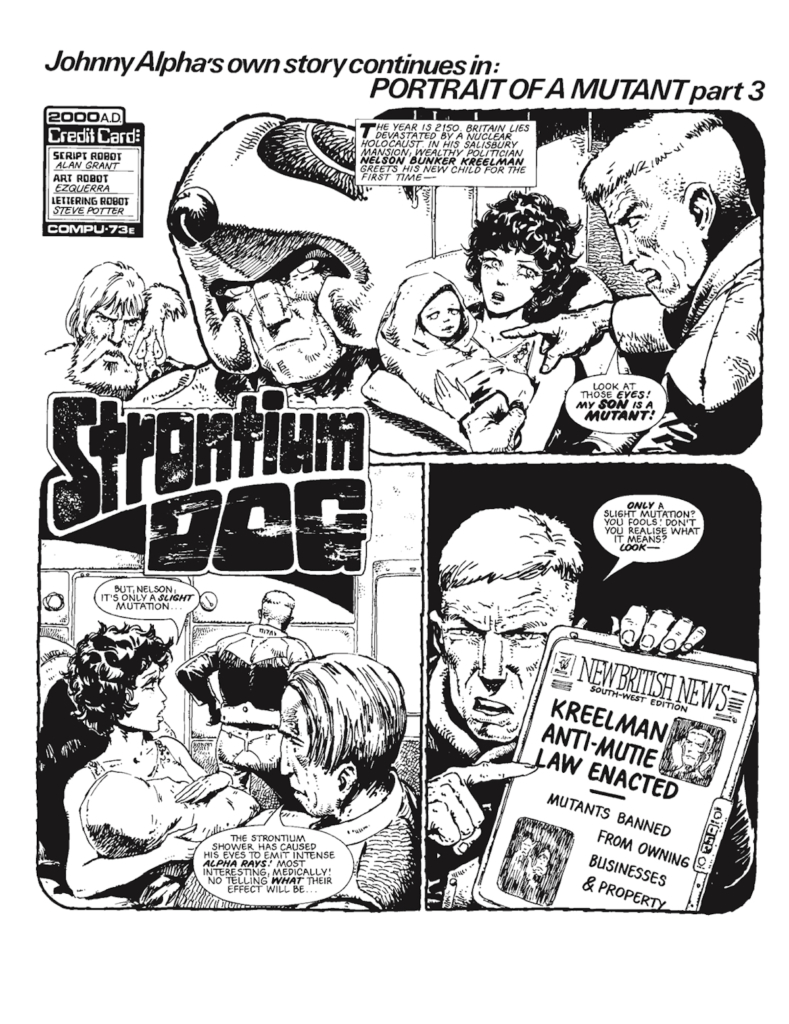
Having dealt with a childhood of neglect and abuse from his father — a radical anti-mutant politician named Nelson Kreeler — because of his mutation, a teenaged Johnny escapes his father’s grasp and quickly rises in the ranks of the Mutant Army. Johnny, with his chip on his shoulder and his glowing eyes, finds himself fighting alongside a smorgasbord of fellow mutants, all armed with weapons, wit, and names cleverly based on their mutations such as the lumpy-headed, oafish Scot, Archie “Middenface” McNulty; Kid Knee; Evans the Fist whose arm is comically large; Kid Knee, whose face (you guessed it) — has grown out of his knee; and the Torso from Newcastle who… well, you get it.
At its heart, Strontium Dog’s core DNA is a formula that is not unlike the X-Men: a brooding character who is othered becomes a part of a community of others who are also “other”; community forms a team, team realizes how powerful they are, bing-bang-boom: one big metaphor that you can copy and paste onto your experience as necessary. The real difference here though, is that, with nearly sixty years of publishing under its belt, the X-Men formula still doesn’t offer one thing: the ability to sustain anger to fruition — an area of storytelling, both in terms of sci-fi narrative and regarding stories of righteous revolution, that the team behind Strontium Dog truly excelled at over the course of its significantly shorter time in the comics history spotlight.
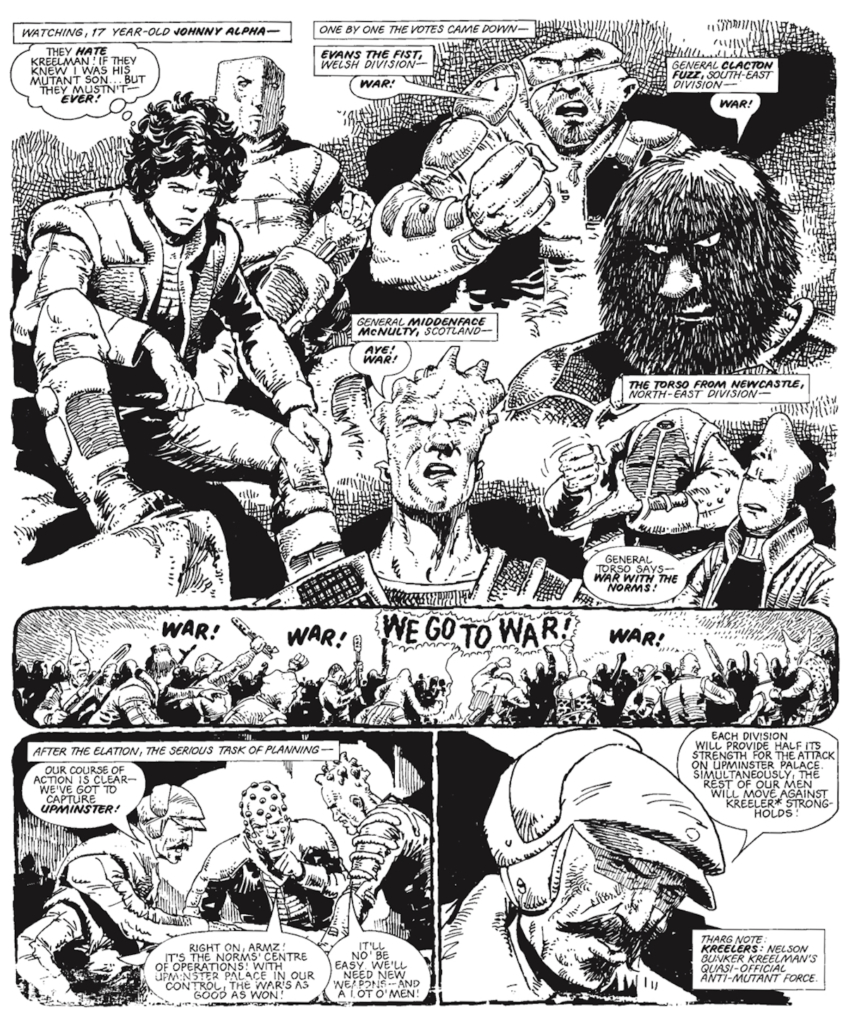
Now, I’m not about to sit here at my desk and try to explain sixty years of X-Men stories. Honing it in, however, we can even just look at the last two decades of X-Men as a primary example of the extent of the boundary pushing allowed within the X-sphere of storytelling. Not only has Marvel’s favorite band of all-age-friendly mutants had their own island nation to welcome humankind called Utopia based off the coast of San Francisco, but, a decade later, they formed an entirely separate second nation on the sentient landmass known as Krakoa, both of which — aside from perhaps the pants-wetting surrounding polyamory being openly hinted at for the first time in Marvel history — haven’t really pushed the “oppressed rising up” narrative forward other than to cause more reason for in-fighting and thus creating…well, other side stories.
While I understand that in-fighting amongst groups is important to any realistic idea of revolution, the consistency of it only really serves to get the group to another stopgap of peace amongst the gang before the cycle can begin again and the anger can be pointed elsewhere before starting over again. Hell, there was a mutant genocide in 2001, and even that was undone a decade or so later! Despite every effort to make the stories relevant to those fighting back against those who would oppress them, we as readers land right back at the beginning. There’s a special irony to how well the X-Men has demonstrated that, for a segment of American mainstream comics, there is no real evolution, only the status quo consistently re-affirming itself, over and over and over again.
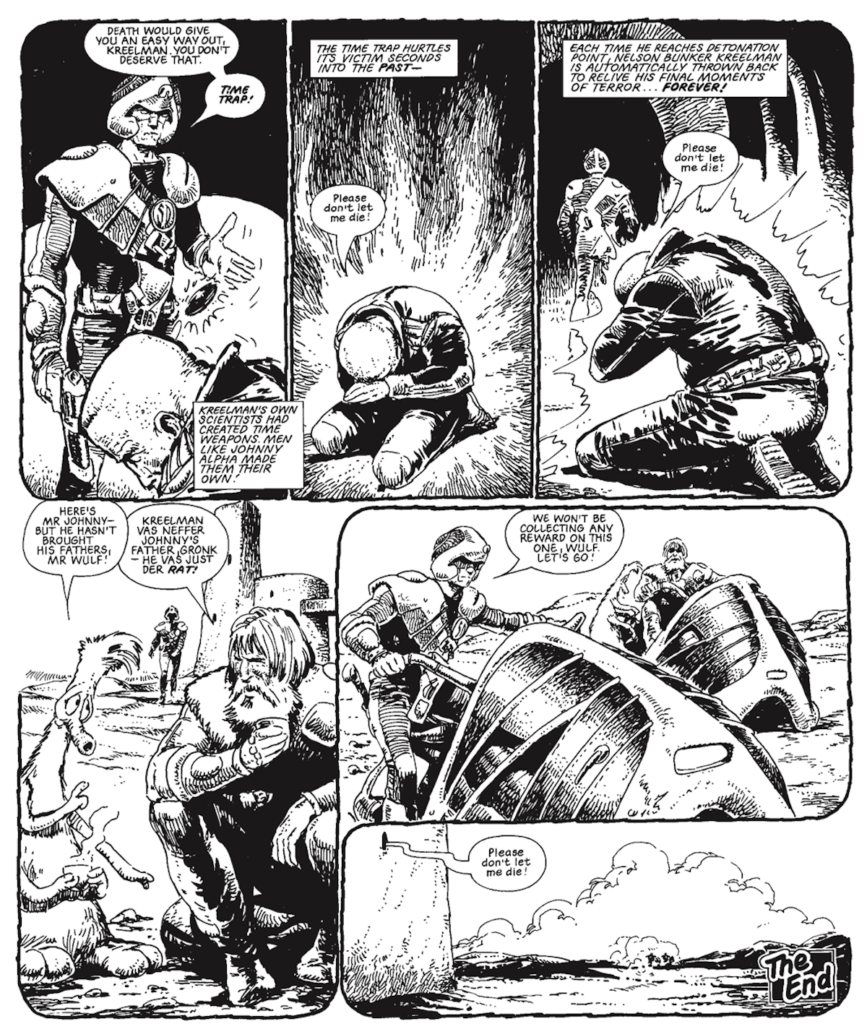
In contrast, one of the first major storylines that we see in Strontium Dog involves the young Johnny Alpha, having spent his short life fuming away under his anti-mutant father, escaping his family home to join the Mutant Army — a group of mutants fighting back against the tyranny of the anti-mutant government. The message of rebellion pushes itself forward by seeing Johnny rewarded for his efforts, and the more he exhibits a righteous anger the more his compatriots band around him and bond with him. That same story proves the larger point, however, as Johnny eventually combats both the larger oppressor and his own demons by trapping his father in a time loop; loudly deposing the openly racist leader of government without a second thought.
One of the defining features of Strontium Dog is that, while there may not always be a happy ending (or a moral one, depending on your own compass), it doesn’t mean that something hasn’t changed or been accomplished from the storyline or the attempt by characters to control their own destinies. Ultimately, in a way that the X-Men somehow seems incapable of, the Strontium Dog story as a whole is one about consequences – not just for those being oppressed, but for everyone. There is a game of perpetual motion at play that only serves to emphasize the nature of revolution, resolution, and the status quo in constant flux, moving forever beyond a repeated stasis.
In many ways, “Portrait of a Mutant” – the story arc that both shows Johnny’s origin story and ends with his father being locked in an endless time loop – sets the stage in a similar way to beloved mutant godfather Chris Claremont’s first era as X-Men writer: both series set stages loaded with political allegories, and delight in refusing to walk back changes to characters and relationships, no matter how unpopular they may be at the time. (If anything, there’s an argument to be made that revolution can sometimes mean winning the war but losing the battles along the way.) The core difference being that, following Claremont’s exit from the X-Men, that franchise became locked in amber with very few changes allowed to become permanent outside of any given writer’s temporary placement. Strontium Dog, however, stayed restless and unwilling to settle down throughout its entire run.
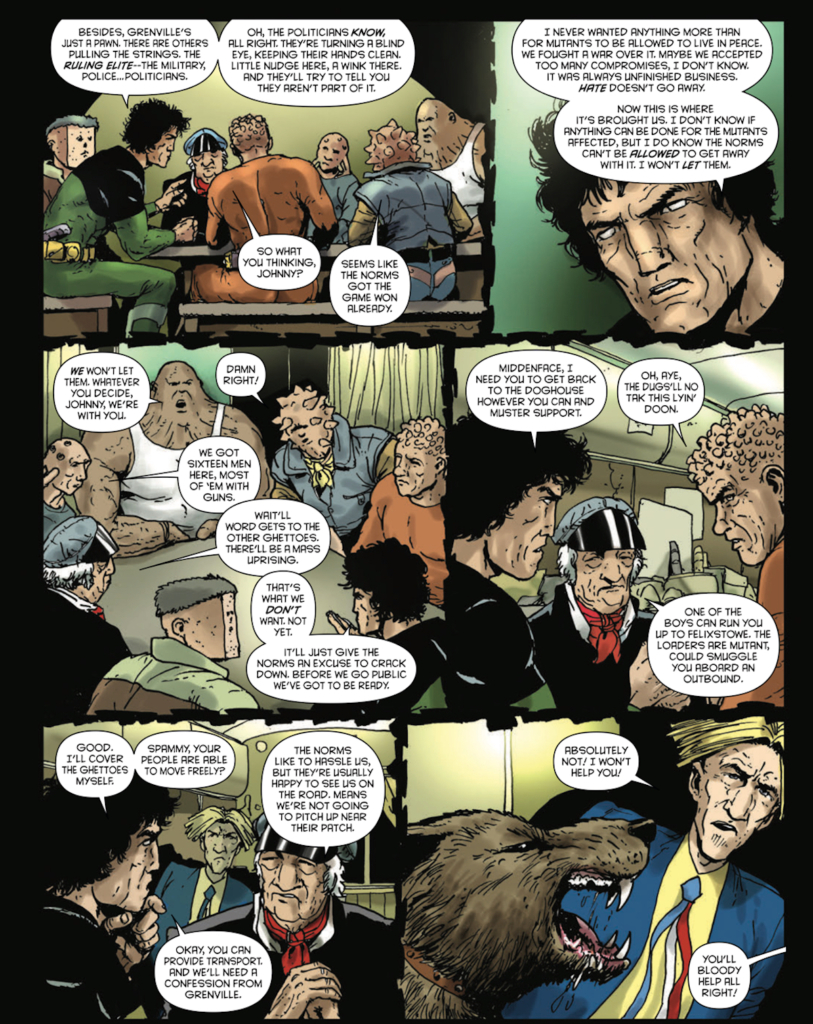
Following the removal of the openly bigoted Kreeler, more insidious and low-key fascists are able to take power. While the mutant war has ended, mutants are forced to live off-world by a government pretending to act as concerned parties worried about remaining ill-feeling between “normies” and mutants; with no other careers open to them – a result of bigoted humans maintaining control over the workforce, after all – mutants are forced to become bounty hunters, leading to the creation of the Search & Destroy Agency, leading to the “Strontium Dog” nickname… something that is a permanent reminder of the origins of their mutations, and a constant slur that they attempt to reclaim.
Later in the series, co-star and sidekick Wulf Sternhammer – that rare thing in the strip, a human who respects mutants – is killed in the line of battle as a consequence of his duty, something that sets Johnny out on a grieving process that shapes his character for decades of publishing history to come. (The immediate story arc following Sternhammer’s death, “Rage,” shows Johnny become emotionally withdrawn as he looks for revenge; it’s considered one of the best stories in the strip’s history.) The idea of a storyline focusing on how his friend’s murder has traumatized Johnny is a decision on behalf of Wagner and Ezquerra that most certainly would have brought Wulf back to life by the next volume in other strips. (How many Jean Grey’s are we on now anyway?)
The fortunate part is that – despite my love of Wulf – the sacrifice on behalf of the readers as well as the characters within the story prove the point that every action requires sacrifice in one way or another, therefore creating a mutant revolution story with real things at stake. With Strontium Dog, there is no empty offer of a political agenda, but a revolution realistic enough to know that there will be fallout for better or for worse and, regardless of those consequences, it is still okay for the revolution to succeed at its expense while not being the end of the story.
This carries over beyond the series’ initial run as well – which ended in 1990, with the seeming death of Johnny; his revival, decades later, was the sole example of the strip choosing to go back on its word in its history – spilling into the revival of the series a decade later, once again written by John Wagner and drawn by Carlos Ezquerra. It shows off what really connects me to Strontium Dog: the fact that Johnny and his ragtag bands of mates are consistently given the room to be angry, and for that anger to have not only real emotional roots, but also consequences.
One of my favorite examples of this is “Mutant Spring” story arc from 2013, a particularly grim storyline where the government has begun a provided food service for the mutant slums, only for Johnny to find out that the food being used to keep low-income mutants alive is only being doled out in an act of false goodwill because it contains a sterilizing agent that has begun to prevent mutants from ever having children.
It’s a sad truth that this kind of story is not unlike something we’d see in real life now – the offering of something seemingly helpful to those in need by the ruling force seeking to subvert them only to have it be something nefarious and somehow work than the loud fascism of straight-up evil.
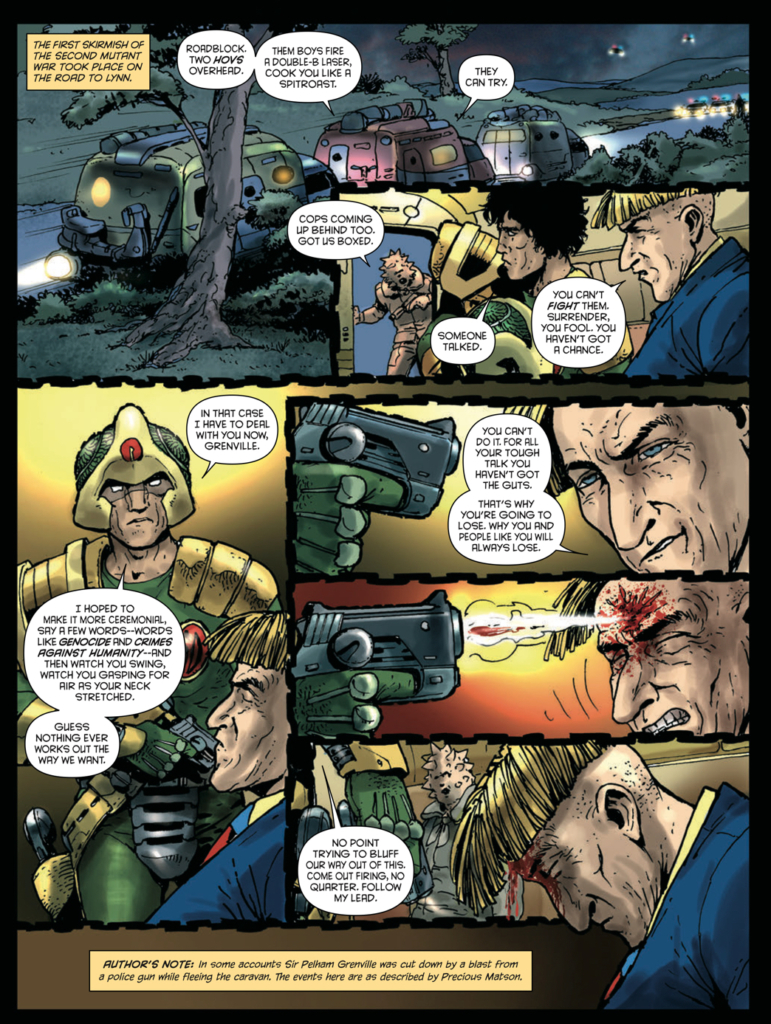
This is not me saying that this kind of story does not also exist within the X-Men history; it absolutely does. In fact, there are countless stories where the non-mutant population is trying to directly eradicate mutants! In Strontium Dog, we get the famously non-pacifistic band of mutants who are here to fuck shit up – but even they find themselves repressed under a call for non-violence, a rally cry of “but we have to be the bigger person or else we won’t truly push forward”. What’s left, after all the repeated abuse and conflict, is a continued fear of being on the wrong side of history, when sometimes the goal is simply to make history at all. As Johnny finally confronts the head of the corporations responsible for the slow, methodical genocide of his people, there are compatriots that push back, because of course they do – there is a moral code among soldiers, after all. Johnny listens and considers carefully, but ultimately shoots him right in the head to make a point to the larger fish in need of frying– a moment that feels like a breath of fresh air despite its moral gray area.
If it’s one thing that people have been able to experience and see firsthand in recent decades, it’s that the fantasy of being an oppressed group able to harness anger is a powerful thing, and Wagner and Ezquerra make it clear that after years of victories, a moral victory is not always enough. Sometimes a price must be paid for the longer suffering.
I guess, all in all, I’ve struggled with the idea of being sold a fantasy that somehow ends up even more shit than the baseline. I understand that there is an additional meta-metaphor here to be had about the grim nature of oppression – pushing back over and over only to be right back where you were to begin with. But this is fiction. This is a world where, in some way or another, there can be a small victory that doesn’t get backtracked. There are consequences to peoples’ actions, regardless of whose side they’re on and regardless of any beef there are between the flavors of the week.
To have mutants – or more broadly, to have revolution – in your comics is to show the fantasy of what can happen to those made lesser by society, not what you may already know in your own experience of that life. Maybe what comics needs after sixty years of waiting for the revolution from the X-Men, it’s just been about looking somewhere else and accepting the fact that we’re allowed to be angry; sometimes it’s okay to just pull the trigger and see what happens.
Happy Birthday, Starlord, and Happy Birthday Johnny!
